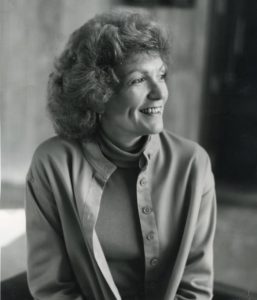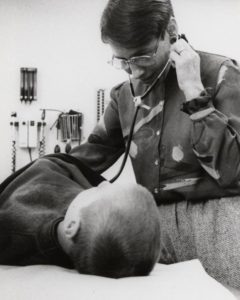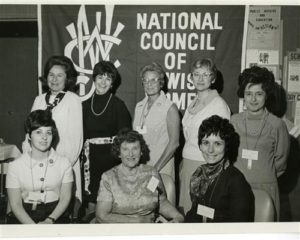For the second year, throughout the month of March, we highlighted different women from our archives on social media thanks to our Archivist Alisha Babbstein.
Shirley Blum Tanzer

Shirley Blum Tanzer was born on April 26, 1929 in Cleveland, Ohio. She graduated from Ohio State University in 1951 with a bachelor’s degree in drama and from Western Reserve University in 1952 with a master’s degree in drama. In 1953 she married Hershal Tanzer and the two moved to Portland, Oregon. She was heavily involved with theater, and helped put together the original musical, “Whatever Happened to Old South Portland?” in 1969, which also spurred her involvement with oral history projects. She started the Oregon Jewish Oral History and Archives Project in 1971 and served as the president of the Jewish Historical Society of Oregon from 1974 to 1977. She taught oral history at colleges and workshops across the country, focusing mainly on the development of Oregon’s Jewish community and the lives of Holocaust survivors. Shirley had three sons, Mylan (who lives in Israel), Marc, and Barak (B.J.). Shirley died August 30, 1994.
Dr. Cecille Beyl

Dr. Cecille Beyl was born in New York City in 1935. Her mother was one of thirteen children of Russian immigrants. Because he had sons to educate, Cecille’s grandfather would not pay for Cecille’s mother’s education; instead, her mother taught piano and bar mitzvah lessons in order to attend college and later medical school. Cecille’s father was a translator for an importing and exporting business; he left the family when Cecille was nine years old. Dr. Beyl’s mother raised her along with her younger brother and sister. Dr. Beyl notes the profound affect her mother’s resilience had on her as she encountered adversity throughout her life.
Dr. Beyl’s family lived in a tenement in the lower east side while she attended public school and her brother and sister went to a yeshiva. In eighth grade she moved with the family to Staten Island. She graduated from high school at 16 and attended Champlain College and then American International College. At 19, while in school, she married her first husband. In 1956 she had her first child, a daughter, and was accepted into medical school. She was one of two women in a class of one hundred. Halfway though medical school she became pregnant again and took a year off before returning and graduating.
In 1967, Dr. Beyl moved to Oregon with her husband and began working in pediatric cardiology. She was invited to be on the faculty at OHSU in 1970, and later returned to school as a full-time student at Portland State University. Her continued education led to a bachelor’s degree in French, a minor in Spanish, and a master’s degree in history.
National Council of Jewish Women, Portland Chapter
On April 29, 1896, sixty-eight women met at Temple Beth Israel to organize the Portland Council of Jewish Women. Matilda (Mrs. Ben) Selling presided. At the end of the meeting Josephine (Mrs. Solomon) Hirsch was elected President. The original charter written by the founding members stated, “We, Jewish Women, sincerely believing that a closer fellowship, a greater unity of thought and purpose, and a nobler accomplishment will result from a widespread organization, do therefore band ourselves together in a union of workers to further the best and highest interests of humanity in fields Religious, Philanthropic and Educational.” The National Council of Jewish Women (NCJW), the parent organization, is the oldest national Jewish Women’s organization in the United States. It grew out of the Jewish Women’s Congress that met for the first time at the Chicago World’s Fair in 1893.
The Portland Council had its first official meeting on May 12, 1896, and appointed committees on religion and philanthropy. Members paid 10 cents a month in dues. These funds offset the cost of operating a sewing school and hosting bible classes. In 1899, the Council joined the Oregon State Federation of Women’s Clubs.
By the turn of the 20th century, the Council grew to include committees on Social Events, Religion, Philanthropy, Sabbath School, Music, Membership, Calendar Planning, Friendly Visiting, and a Junior Section. The members became involved in contemporary political issues including child labor laws and food safety. The yearly dues were raised to two dollars and associate membership for men was established. The first fund-raising activities began in 1901. This was also the period that the Council established a number of neighborhood programs and classes to assist in settling new immigrants.
By 1910, the Council had 342 members. The programs had outgrown the space at SW First and Lincoln. The renowned architect A.E. Doyle designed a new Neighborhood House building at what became 3030 SW 2nd Avenue. The members and the general community raised $40,000 for the new building which opened in December of 1910. The Council’s focus from 1910 through the mid-1920s was on the classes and programs provided at the Neighborhood House. The growing numbers of Italian and Jewish immigrants to South Portland prompted the Council to increase the programs offered to integrate those immigrants into the community.

One of the most ambitious projects that the Council undertook in the 1920s and 30s was the establishment of hospital beds for indigent Jews in perpetuity at St. Vincent, Good Samaritan, and Emanuel hospitals. The money for this project was drawn from the Memorial and Happy Day Fund.
The Council remained active during the Great Depression despite having to lower annual dues in response to the needs of the membership. A statewide survey of Oregon’s blind population in 1933 identified needs in that community which led the Council to provide walking canes and to support legislation to set up pensions for blind Oregonians in need. The work with the blind was a part of the organization’s efforts until the mid-1950s. The Council also collected clothes for school children, sponsored B’nai B’rith camp scholarships, and provided foodstuffs to the Oregon State Relief Council’s Multnomah County Canning Kitchen.
In the years prior to World War II, the Council focused its political efforts on supporting birth control and sexual health education, but the alarming condition of German Jews led to a number of new initiatives for the Council. They protested the German treatment of Jews throughout the 1930s with a letter-writing campaign. The organization also raised money for a German Jewish Children fund. Other programs helped people in Germany locate relatives living in the United States, reuniting families. Council sponsored discussions on American neutrality, organized boycotts of German-made goods, and drafted resolutions to prevent the sale of weaponry or raw materials to enemy belligerents. During World War II, the Council hosted blood drives, participated in war bond sales, and distributed ration books. They housed soldiers in the Neighborhood House and Portland’s second USO center was established there.
In 1948 there were 473 paid members of the Council, who by that time referred to themselves as the Portland Section National Council of Jewish Women. During the postwar period, the Section supported the national organization’s efforts to raise money, collect food, and send supplies overseas. In addition to supporting the establishment of Israel through political action and fundraising for Zionist ventures, several committees focused on international relations and contemporary Jewish affairs. Locally, the Section joined the National’s Ship-A-Box program that provided toys and educational materials to Jewish children in European and Middle Eastern countries. The Section operated a number of programs at Neighborhood House that helped recently arrived immigrants and area residents integrate into the community. In 1950, the Section began the first nonsectarian Program for the Aged in the state of Oregon. This program was part of the national NCJW campaign to provide recreational programs for the nation’s elderly. Two years later, the Section organized a recreational program for youth incarcerated at the Multnomah County Juvenile Detention Home.
With volunteerism on the rise in the postwar years, the Section’s growing membership-supported oversees programs and volunteered in local community service and child advocacy. In the 1950s, the Section established the Blue Star Circle, a recreation program for senior citizens that became the Seniors Program at the Jewish Community Center.
The need for stable funds to support Section projects and programs led to the opening of the Council Thrift Shop in 1964. The first location of the Thrift Shop was SW 3rd and Yamhill. Members donated used clothing and household items and volunteered in the operation of the shop. The annual Angel Ball was created as an incentive for involvement. The Angel Ball Committee tabulated volunteer hours and dollar value of donations and donors above a certain level received an invitation to the Ball. They were elegant affairs, very popular with the membership. The Angel Ball continued to be a Section tradition through the 1980s.
In 1968 the Section began a volunteer program at the Albina Child Development Center and also provided funding to hire an additional staff member for the facility. This effort reached into a part of the community that was new for the Portland Section. Subsequent efforts in Northeast Portland included support of the Iris Day Court public housing project. In addition to these projects, the Section began service to Planned Parenthood and Portland Adult Literacy.
